
How many times in the last few weeks have you noticed the welding quality on your vehicle, wheelbarrow, or anything else?
I'm willing to bet you haven't. Understandably, you didn't. We don't notice something unless it stands out from the others. For some people, a poor weld job is like looking at a room and knowing something is out of place. You can't put your finger on it, but it nags at you.
The fact the beginning of the story evolved from pounding copper together 3,000 years ago to something taken for granted involves a long story.
The Internet of Things (IoT) has the potential to drive innovation in a variety of industries, and the manufacturing industry is no exception. In fact, manufacturers face an opportunity to leverage the IoT to improve their operational efficiency and margins.
Manufacturers need to integrate sensors into their production processes to achieve these benefits. Welding technology is one of the manufacturing plants' most expensive areas; after all, they're building welded structures from steel and other materials. Therefore, it's an excellent use case for the IoT and its ability to monitor real-time data cost-efficiently.
To appreciate how welding has influenced our daily lives, we need to take a step back and look where it started.
Welding's Distant Past
Not surprisingly, seeds of modern welding were planted several thousand years ago during the Bronze Age. Our ancestors discovered that softer metals, like bronze and copper, could be joined using basic tools. They hammered two pieces of metal, while under heat, until joined.
The Egyptians, always ahead of the curve, discovered a method of combining several pieces of iron together. Archeologists discovered small gold boxes that had lap joints pressure-welded from over 2,000 years ago.
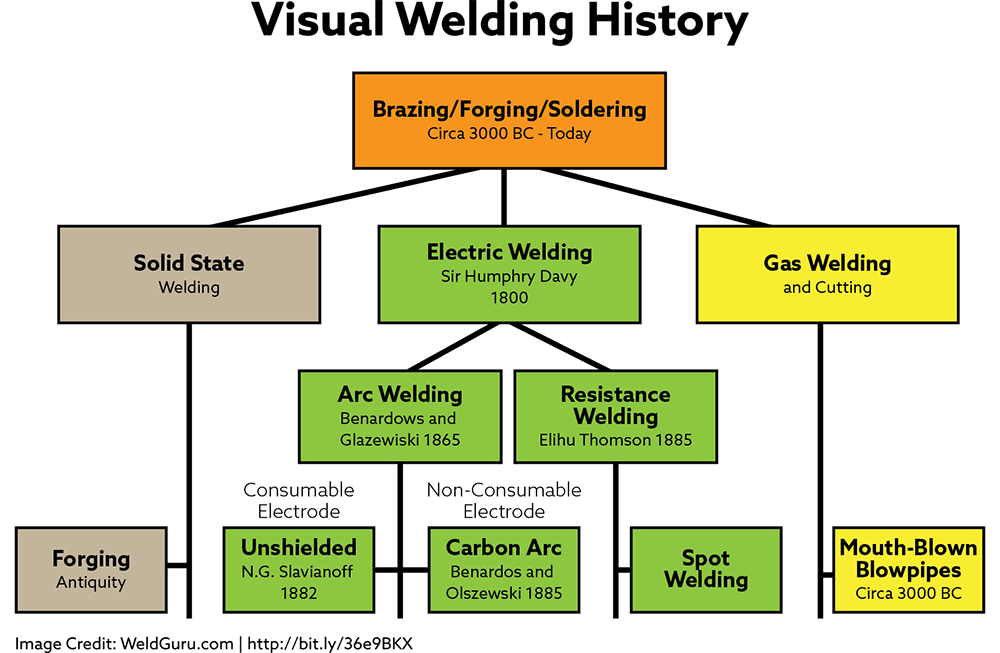
Evolution of Welding
Welding is like most modern processes; there isn't a single person who invented it. Instead, many people over hundreds of years contributed their ideas resulting in the many forms we see today.
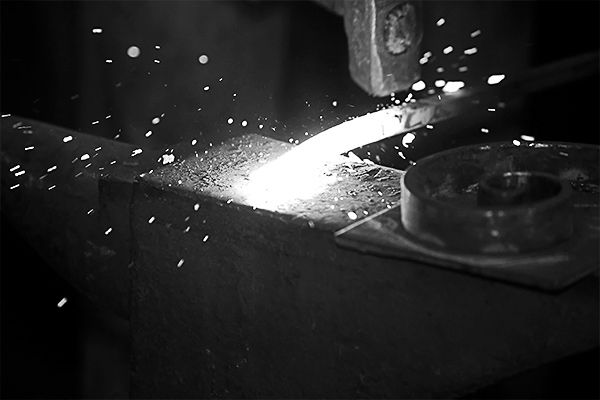 Blacksmithing during the Middle Ages made items made from iron welded together by constant hammering. This was the go-to method of combining pieces of metal until the 19th Century.
Blacksmithing during the Middle Ages made items made from iron welded together by constant hammering. This was the go-to method of combining pieces of metal until the 19th Century.
Sir Humphry Davy started the 19th Century off by creating electric arcs between two carbon electrodes using batteries. In 1836, Sir Edmund Davy (Humphry's cousin) discovered acetylene, although it wasn't used yet, it opened the door for oxy-fuel welding and cutting.
During the rest of the 19th Century, numerous advances and patents advanced the process. Even Eli Whitney of cotton gin fame was involved. His invention of interchangeable parts let to iron dies and mold manufacturing.
Fast-Tracking the Process
 As always, wars sped up the welding process.
As always, wars sped up the welding process.
Before World War I, ships were made by riveting two metal pieces together. This method changed during the war. Demand for reliable ships, tanks, weapons, and planes became possible when companies produced commercial weld machines and electrodes.
American Welding Society
In 1919, after the war, the American Welding Society was founded by 20 members of the Wartime Welding Committee of the Emergency Fleet Corporation. The AWS, lead by Avery Adams, became a non-profit organization committed to advancing the process.
Post-WWI
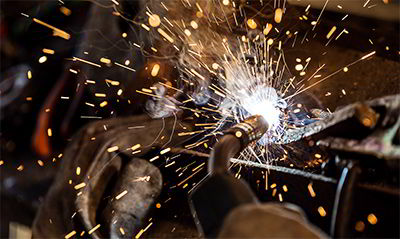 Between the end of World War I to today, welding advanced thanks to dozens of discoveries. One crucial process was developed in 1948: gas metal arc welding (GMAW) by C.B. Voldrich, P.J. Rieppel, and Howard B. Cary.
Between the end of World War I to today, welding advanced thanks to dozens of discoveries. One crucial process was developed in 1948: gas metal arc welding (GMAW) by C.B. Voldrich, P.J. Rieppel, and Howard B. Cary.
GMAW used gas shielded arc, similar to gas tungsten arc, but a continuously fed electrode wire replaced the tungsten electrode. Using very thin electrode wire and constant-voltage allowed the GMAC process to become widely used based on cost-effectiveness.
Increased global competition forced companies to improve their processes leading to the concept of industrial automation using robotics.
The Advent of Robotics
Robotics is popular in various manufacturing operations. There are instances where people performing these tasks are in a more dangerous position than others. These situations are where robotics makes its mark in manufacturing.
A robot developed by two men, George Devol and Joseph Engelberger, was used in a General Motors factory for spot welding on an assembly line, which was considered dangerous for people.
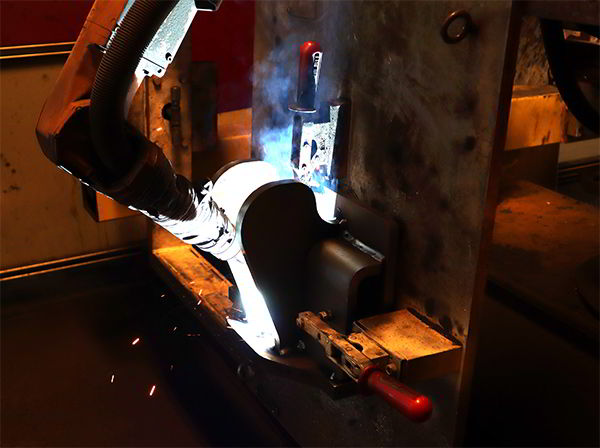 It took almost 20 years before robotic welding took off, primarily in the automotive industry. Other automotive manufacturers implemented their robotic spot welds to gain the benefits General Motors earned from their robotics program.
It took almost 20 years before robotic welding took off, primarily in the automotive industry. Other automotive manufacturers implemented their robotic spot welds to gain the benefits General Motors earned from their robotics program.
Soon after the automotive industry proved the viability of robotic welding, the technology moved across several industries maintaining quality while controlling costs.
Over 60,000 robotic weld cells worked throughout North America in 2005.
Gradually, the popularity of arc welding grew, and robotic welders became smarter using more axes and 3D vision. Using robotics provides three primary benefits:
- Quality: repeatable, high-quality, precise welds
- Productivity: robotic welders work fast, produce simultaneously complicated welds, reliable repeatability, and don't get tired
- Safety: Robotic welds eliminates exposure to toxic fumes and hazardous environments.
As robotic welding became common, its other half became just as important: programming.
Software Making Changes
Companies using robotic welders rely on accurate schematic drawings for quality welds. Offline programming used by some companies, including Schuette Metals, simplifies the process. Instead of adding parameters to the robotic unit while on the floor, technicians download the program to the weld unit from a network file.
The wide-scale use of the IoT has already started. With improved broadband internet, increase smartphone usages, lower technology, and connection costs, and a more significant number of things built with Wi-Fi technology.
Since we're becoming tightly connected, a need arose to create a sort of network of communication between those devices.
Meet the Internet of Things (IoT)
Forbes provides the simplest definition of the IoT:
Put, this is the concept of basically connecting any device with an on and off switch to the Internet (and/or to each other). This includes everything from cellphones, coffee makers, washing machines, headphones, lamps, wearable devices, and almost anything else you can think of.
This also applies to components of machines, for example, a jet engine of an airplane or the drill of an oil rig...The IoT is a giant network of connected "things" (which also includes people). The relationship will be between people-people, people-things, and things-things.
Or to summarize, the IoT is software talking with software.
Although it sounds like something only a computer-geek would appreciate, the IoT looks to have a significant impact on manufacturing.
Industry 4.0
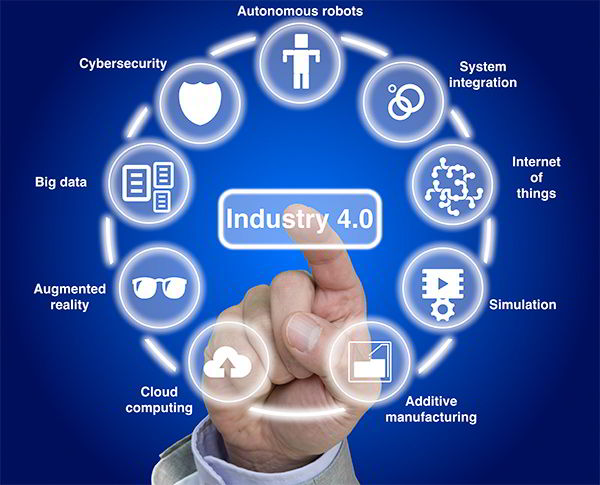 The speed and way digitized manufacturing are making products has been referred to as Industry 4.0.
The speed and way digitized manufacturing are making products has been referred to as Industry 4.0.
Referred to by other names in history, Industries 1.0 to 3.0 are commonly known:
- Industry 1.0: Industrial Revolution
- Industry 2.0: Mass production and assembly lines using electricity
- Industry 3.0: Adoption of computers and automation
Computer technology disrupted manufacturing because it was brand new. As we enter Industry 4.0, computers are connected and communicate, making decisions without people. This interconnectivity creates the concept of a smart factory.
Again from Forbes:
Ultimately, it's the network of these machines that are digitally connected and create and share information that results in the real power of Industry 4.0.
IDC Predictions
The International Data Corporation (IDC) predicts three keys for the manufacturing industry.
- Manufacturing Operations: IoT used for intelligent manufacturing, monitoring and enhancing performance, and production line planning.
- Production Asset Management and Maintenance: monitors key performing parameters related to quality, damage and breakdowns, performance, and bottlenecks.
- Field Service: it takes on the role of a service provider by maintaining constant monitoring of connected devices. If an issue is detected, the system contacts the field service representative giving the problem. If that problem is a failing component, the field tech takes a replacement with him. This point is significant because of the time savings. The new component shows up right away instead of a service call, diagnosis, part ordering, delivery wait time, and another service call.
So, How Does the IoT Impact Welding?
The evolution of robotic welding into manufacturing opened up avenues of potential not imagined when the first robotic showed up in the 1960s.
Predictive and preventative maintenance may have the most significant impact provided by the IoT. I may be oversimplifying, but looking at human versus IoT maintenance programs shows the differences.
Summing that process up a field tech:
- Spends time traveling to your facility
- Takes more time to examine and locate the issue
- Orders the replacement part
- Cruises back to your facility
- Installs the new component.
Using the IoT vastly improves this process. When the weld machine breaks down, diagnostic software:
- Determines the issue
- Automatically orders a replacement part
- Has it shipped to the field tech making a single trip to your facility
In Sum
The Internet of Things is changing how we interact with technology. It's an emerging technology that allows us to connect all kinds, or virtually all, types of devices together. It all stems from a simple premise: internet-connected things can automatically and seamlessly interact with one another. Think of it as making sure all home appliances are always smart.
As IoT continues to expand, more and more manufacturers are implementing artificial intelligence into their systems, which opens up the ability for companies to interact with the outside world even when they are offline. These advancements might revolutionize the way we do things, but they also present some challenges.
First, the IoT requires software to be programmed and configured. There are a variety of open-source and proprietary applications that allow manufacturers to make adjustments based on real-world data.
Second, IoT doesn't work without reliable, secure communication between connected devices. The word secure is critical here. Even when the manufacturer, maintenance technician, and field service rep have installed alarms, people don't consider the IoT secure because the device is still potentially falling into the wrong hands.